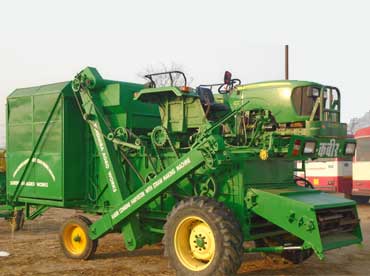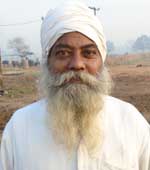Genesis
Prasad recalls the introduction of a combine machine from Punjab in his region in 2007 for harvesting crops. Though quite useful, it was unable to thresh and also left behind straws of crops. Farmers, in a bid to get rid of the straws, used to set them on fire, causing harm not only to the environment, but also to their agricultural land as burning leftover stalks reduces the fertility of land. This led Surendra to think about a machine, which he started developing in August 2010 and completed in April 2011. With many trials, experiments and subsequent modifications, he was able to finalise the design in April 2014.
The modified combine harvester
It is a tractor operated modified combine harvester with the provision of collecting chaff. The machine has been manufactured to enable farmers perform both the tasks viz. harvesting and threshing simultaneously. It can be operated using tractor of 65 hp and above.
The combine harvester, having two separate chambers for storing fodder and wheat grains, cuts stalk of wheat in a manner, which minimizes the loss of grains and fodder during harvesting. The chances of wheat grains getting cut or damaged is considerably low due to the mechanism used in the machine, which separates fine-quality grains from wheat straws very quickly. This machine harvests one acre (2.5 bigha) of standing crop in an hour. The crop storage chamber of the machine can store wheat up to eight quintals whereas the straw collecting chamber can collect and store about six to eight quintals of straw. Prasad has also filed a patent application for his innovative technology.
Surendra Prasad (55), who is in the profession of agriculture machinery manufacture and repair, has developed a harvesting machine, which can be used for simultaneous harvesting, threshing and collection of straw.
Prasad's father had expired when he was still in primary school due to acute tuberculosis infection. As his family struggled to make ends meet, he left his studies and began helping his elder brother to earn livelihood for their family of seven. The meagre income from agriculture proved to be insufficient for his family, which prompted him to start a cycle-repairing shop near the village. However, he had to close the shop after a couple of years as its income brought no substantial difference to his family's pitiable economic condition. He then moved out and undertook odd jobs for two- three years in Punjab and West Uttar Pradesh before finally returning to his village in 1985. He then started a tractor repairing workshop Surendra Agro Works, about four kilometers from his village. He lives with his wife and three sons, who help him in his workshop.








